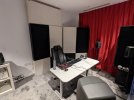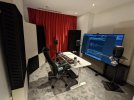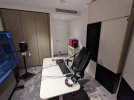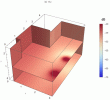A little bit of math to support my reflections idea:
What's driving me nuts is the summation - or lack thereof - between the left and right speakers around 90 Hz.
90 Hz = 3.82 m wavelength. A reflection half of that wavelength,
1.91 m, will cause cancelation. That reflection arrives after the direct sound so we also need to take to speaker-listener distance into account, about 1.7 m. So the
total reflection path (speaker > boundary > listener) is about 1.9 + 1.7 =
3.6 m long.
1.9 m relative reflection path length = 5.52 ms. In your "
same graph without zero phase filtering" graph we effectively see the front left delay (purple) jumps to about 5 ms from 30 ms on ...
The total reflection pathlength of 3.6 m is about the distance from left speaker > left corner/window > listener. Also left speaker > left back corner > listener is an option.
In your experiment with moving the speakers and microphone we see the cancelation frequency changing when moving the microphone left to right (purple and green measurement). The '
Mic 70 cm right' measurement is interesting as it shifts the cancelation frequency 10 Hz down. This makes sense, as moving away from the window increases the reflection pathlength, which lowers the cancelation frequency. The 80 Hz cancelation we see here corresponds to a wavelength of 4.3 m, half wavelength is 2.15 m while the original one (for 90 Hz) was 1,91 m.
The measurement "
Mic 70 cm front" shifts the cancelation frequency even further down. Knowing this kind of shift requires the reflection pathlength to increase, this confirms the reflection is running via the left back corner. The front corner is out as a move to the front decreases the length of this reflection. So the solution could be to place an additional bass trap in the back corner. Although according to my experience you need a lot of absorption to tackle such a boundary reflection.
This is just a bit of brainstorming in an attempt to understand what could be happening, but given the size of the room with all these boundaries in close distance it's impossible to predict if this scenario makes sense. You would need to test to verify it, for example by placing a bass trap in the back corner (but don't use the front one because that might already play a role in handling the front reflections).
Worst case this was all nonsense, especially since I did the math on the back of a napkin while attending a meeting






